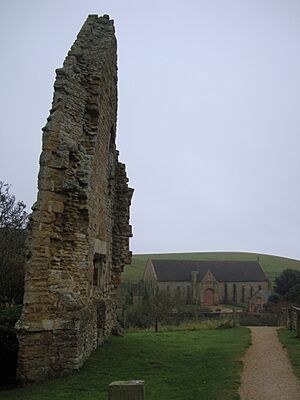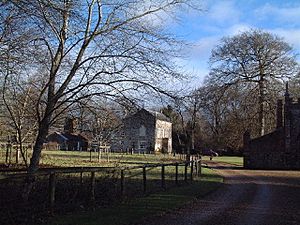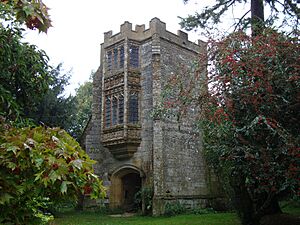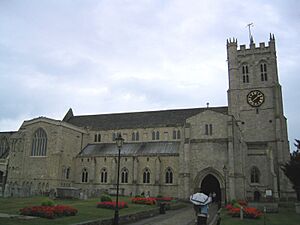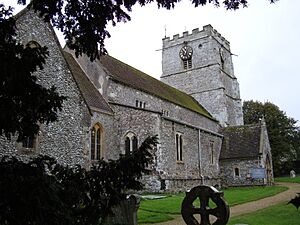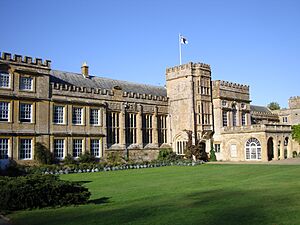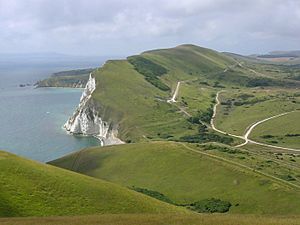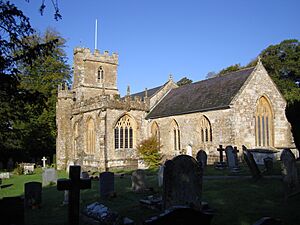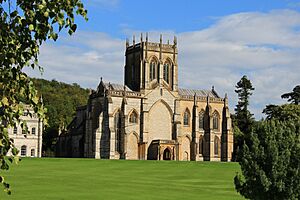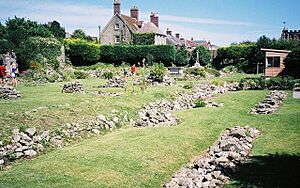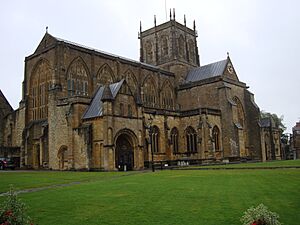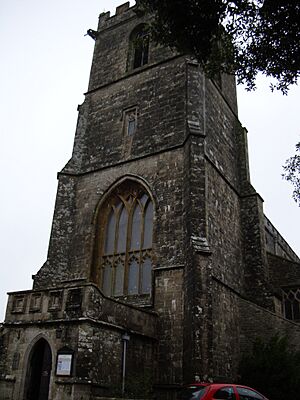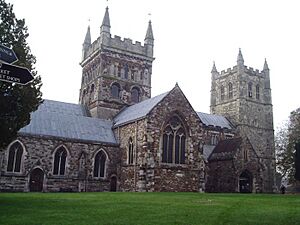List of monastic houses in Dorset facts for kids
Monastic houses were special places where groups of people, like monks and nuns, lived together a long time ago. They dedicated their lives to prayer, study, and helping others. These communities were often called abbeys or priories.
In Dorset, England, there were many such houses. They played a big part in the history of the area. Some were very old, even from before the Norman Conquest in 1066. Over time, many of these places changed. Some were destroyed, others became private homes, and a few are still used today. This list tells you about the different monastic houses that once existed in Dorset.
Alien houses are included, as are smaller establishments such as cells and notable monastic granges (particularly those with resident monks), and also camerae of the military orders of monks (Knights Templars and Knights Hospitaller). Monastic hospitals are included where they had the status or function of an abbey, priory, friary or preceptor/commandery.
- Abbreviations and key
| Symbol | Status |
|---|---|
| None | Ruins |
| * | Current monastic function |
| + | Current non-monastic ecclesiastic function (including remains incorporated into later structure) |
| ^ | Current non-ecclesiastic function (including remains incorporated into later structure) or redundant intact structure |
| $ | Remains limited to earthworks etc. |
| # | No identifiable trace of the monastic foundation remains |
| ~ | Exact site of monastic foundation unknown |
| ≈ | Identification ambiguous or confused |
Locations with names in italics indicate possible duplication (misidentification with another location) or non-existent foundations (either erroneous reference or proposed foundation never implemented) or ecclesiastical establishments with a monastic name but lacking actual monastic connection.
| EH | English Heritage |
| LT | Landmark Trust |
| NT | National Trust |
Monastic Houses in Dorset
| Foundation | Image | What Kind of Community? | Formal Name or Other Names | ||||
|---|---|---|---|---|---|---|---|
| Abbotsbury Abbey | Started around 1026 by Orcus, a steward for King Canute. | Later became a home for Benedictine monks from Cerne Abbey in 1044. | It closed down in 1539. Today, parts of it are privately owned or used by the local church. | The Abbey Church of Saint Peter | Abbotesbury Abbey; Abbodesbirig Abbey | ||
| Beaminster | This was a very old community, possibly monastic, existing before 862. | Bebingmynster | |||||
| Bindon Abbey | Home to Cistercian monks. | They moved here from Little Bindon in 1172. | The abbey closed in 1539 and is now privately owned. | ||||
| Blackmoor Priory Hermitage | This was a hermitage, a place for hermits, by 1300. | The brothers there seemed to follow rules similar to Augustinian Friars. | It was abandoned after 1424. | Hermitage | |||
| Bridport Whitefriars (?) | Thought to be a place for Carmelite Friars, started in 1261. | It probably stopped existing before 1365. | |||||
| Bridport Priory | The type of religious group here is not fully known. | It was later turned into a home called 'St Jones'. | |||||
| Cerne Abbey | A monastic site before 604, possibly founded by St Augustine. | It became home to Benedictine monks before 987. | The abbey closed in 1539. Its remains are now part of a private house. | St Peter; St Mary, St Peter and St Benedict; St Edwold (St Athelwold) | Cernell Abbey | ||
| Charminster | An old monastic or religious community from before the Norman Conquest. | The current parish church of St Mary might be built on its site. | |||||
| Chilcombe Camera | This was a place for the Knights Hospitaller, a military religious order. | It closed before 1308. | |||||
| Christchurch Priory | There's a long tradition of a monastery here. | It became home to Augustinian Canons Regular in 1150. | The priory closed in 1539. Its church is still used as a local church today. | The Priory Church of Christ, Christchurch; Church of the Holy Trinity, Twyneham | Twyneham Priory; Twinham Priory | ||
| Cranborne Priory | An early monastery, possibly started around 980 for Benedictine monks. | It later became a smaller priory, dependent on Tewkesbury Abbey. | It closed in 1540. | The Abbey Church of the Blessed Virgin Mary and Saint Bartholomew; The Priory Church of The Blessed Virgin Mary and Saint Bartholomew, Cranborne | Cranbourne Priory; Cranburn Cell | ||
| Dorchester Greyfriars | This was a home for Franciscan Friars Minor, started before 1267. | It closed in 1538. | |||||
| Forde Abbey | A home for Cistercian monks. | The community moved here from Brightley in Devon around 1146. | It closed in 1539. Today, the old monastery buildings are part of a mansion that people can visit. | ||||
| Frampton Priory | This priory was for Benedictine monks. | It was an alien house, meaning it was controlled by a monastery in Normandy, France. | It was founded before 1077 by William the Conqueror. | It closed before 1414. | |||
| Fryer Mayne Preceptory | This was a base for the Knights Hospitaller. | It was founded before 1275. | It later merged with another house and closed down. | Friary Mayne Preceptory; Friar Mayne Preceptory; Freyer Mayne Preceptory; Mayne Preceptory; Mayne Ospitalis | |||
| Gillingham Friary | Possibly a home for Dominican Friars, started around 1267. | There isn't much information about it after that time. | |||||
| Gillingham Minster | This was a Saxon minster, an early type of church community. | The current St Mary's Parish Church might be on its original site. | |||||
| Hilfield Friary | This is a modern community for Franciscan Friars. | It was founded in 1921 and is still active today. | The Friary of Saint Francis, Hilfield | ||||
| Holme Priory | Home to Cluniac monks. | It was an alien house, dependent on Montacute, but became independent in 1407. | Founded around 1142, it closed in 1539. | The Blessed Virgin Mary | East Holme Priory; Holne Priory; Holme Cell | ||
| Horton Priory | An abbey for Benedictine monks, founded in 961. | It was likely destroyed by Danish raids, then refounded around 1050. | It became a smaller priory, dependent on Sherborne, in 1122. | It closed in 1539. An 18th-century church now stands on its site. | St Wolfrida | Horton Abbey; Horton Cell | |
| Iwerne Minster | An old monastic or religious community from before the Norman Conquest. | The parish church of St Mary might be built on its site. | |||||
| Kingston Camera | Another place for the Knights Hospitaller. | It was connected to Fryer Mayne. | |||||
| Little Bindon Abbey | This was the first home for Cistercian monks who later moved to Bindon Abbey in 1172. | Founded in 1149, much of its stone was used to build Lulworth Castle. | |||||
| Loders Priory | Started around 1107 for Benedictine monks. | It was an alien house, controlled by a monastery in Normandy. | Later, it was used by Carthusian monks and then Brigetine nuns. | The Priory Church is now used as a local church. | St Mary Magdalen | Lodres Priory | |
| Lulworth Abbey | A community for Trappist monks who came from Switzerland in 1795. | It became an abbey in 1813 but the monks had to leave England in 1817. | The Monastery of the Most Holy Trinity, Lulworth | ||||
| Lyme Friary (?) | This was planned to be a home for Carmelite Friars, but it seems it was never actually built. | Lyme Regis Friary | |||||
| Lytchett Minster | An old monastic or religious community from before the Norman Conquest. | ||||||
| Melcombe Priory, Melcombe Regis | A home for Dominican Friars, founded in 1418. | It closed in 1538. | Milton Friary; Melcombe Regis Friary | ||||
| Milton Abbey | First a college founded by King Athelstan in 938. | It became a home for Benedictine monks in 964. | The abbey was rebuilt after a fire in 1309. | It closed in 1539. Today, the Abbey Church is used by Milton Abbey School and is open to the public. | The Priory Church of Saint Michael and Saint Mary, Milton; The Abbey Church of The Blessed Virgin Mary, Saint Samson and Saint Branwalader, Milton | Middleton Abbey | |
| Muckleford Grange | Possibly a small community for Tironensian monks. | It was an alien house, connected to Tiron Abbey in Normandy. | |||||
| Piddletrenthide Priory | A small community for Benedictine monks, connected to Hyde Abbey. | It closed around 1354. | Piddletrenthide Cell | ||||
| Poole — St George's Friary | This was a property of the Friars of St George, likely a guild. | ||||||
| Povington Priory | An alien house for Benedictine monks, connected to Bec Abbey in France. | It closed in 1230. | Povington Grange | ||||
| Shaftesbury Abbey | Founded around 888 by King Alfred for Benedictine nuns. | It was refounded later and became a very important abbey. | It closed on March 2, 1539. Its ruins are now part of a walled garden. | The Abbey Church of Saint Mary, Shaftesbury; The Abbey Church of Saint Mary, Saint Edward, King and Martyr, Shaftesbury | |||
| Shaftesbury Minster | A very old Saxon nunnery, possibly from before 670. | It might have been destroyed by Danish raids. Shaftesbury Abbey was possibly built on its site. | |||||
| Shapwick Grange | This was thought to be a priory, but its exact history is unclear. | It was later acquired by the Carthusians. | Shapwick Priory | ||||
| Sherborne Abbey | Founded before 672, it was a Saxon minster and a bishop's seat. | It became a cathedral priory for Benedictine monks around 993. | It was raised to abbey status in 1172. | It closed in 1539. The church is now used as a local church, and the old monastic buildings are part of a public school. | The Blessed Virgin Mary | Shireburn Abbey | |
| Spettisbury Priory | An alien house for Benedictine nuns, connected to a monastery in France. | Founded before 1100, it closed in 1535. | dedication unknown | Spetisbury Priory; Spectesbury Priory | |||
| St Monica's Priory, Spetisbury | This priory had several different religious groups over time. | It was home to Augustinian Canonesses Regular, then Bridgettine Nuns, Canons Regular, and Ursuline Nuns. | It was sold in 1927. | The Priory of Saint Monica, Spetisbury | |||
| Stour Provost Grange | An alien house for Benedictine monks, connected to a monastery in France. | Founded around 1070, it closed around 1471. | |||||
| Sturminster Marshall | An old monastic or religious community from before the Norman Conquest. | ||||||
| Sturminster Newton | An old monastic or religious community from before the Norman Conquest. | ||||||
| Tarrant Abbey | First, it was a place for "Anchoresses" (women who lived alone for religious reasons) around 1186. | It became a home for Cistercian nuns around 1100. | It was raised to abbey status before 1228. | It closed in 1539. Today, Abbey Farm is on its site. | St Mary and All Saints | Tarrant Crawford Abbey; Tarrant Kains Abbey; Tarrent Abbey; Tarrant Cell; possibly 'Camesterne' ('Camestrum') (St Mary Magdalene) | |
| Wareham Nunnery | Reputedly founded around 672 for Benedictine? nuns. | It was said to be destroyed several times by Danish raids. | A Benedictine priory was later built on its site. | The Blessed Virgin Mary | monasterium of holy virgins | ||
| Wareham Priory | An alien house for Benedictine monks, connected to Lyre Abbey in France. | Founded in the 12th century on the site of the earlier nunnery. | It closed in 1414, then was granted to the Carthusians. | It closed again in 1536. A house called 'The Priory' was built on its site in the 16th century. | Lady St Mary Priory | Warham Priory | |
| West Lulworth Priory | A community for Cistercian monks from Forde Abbey. | Founded in 1149, they moved to Bindon in 1172. | |||||
| Wilcheswood Monastery | The type of religious group here is not fully known. | It was founded in 1373 and seems to have closed in 1536. | St Leonard | Wilcheswood Priory; Wilkswood Priory | |||
| Wimborne Minster | Founded before 705 by Cuthburh for Benedictine? nuns and monks. | It was later changed into a college for secular canons. | It closed in 1547. | St Cuthburga | Winburn Priory; Twinborn Priory | ||
| Winterborn Monkton Grange | An alien house for Cluniac monks, connected to Cluny in France. | Founded before 1214, it closed around 1450. | Winterborn Grange; Winterborn Monckton | ||||
| Yetminster | An old Saxon minster, an early type of church community. |
See also


